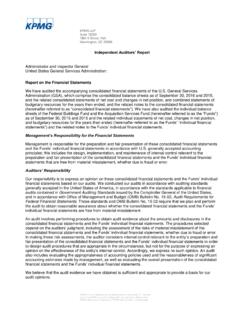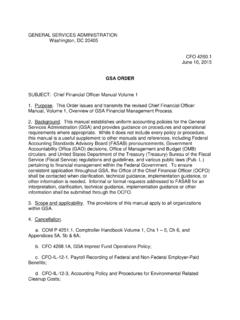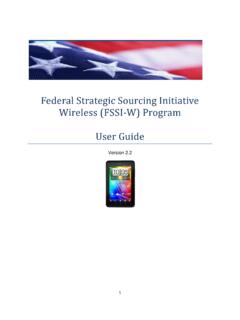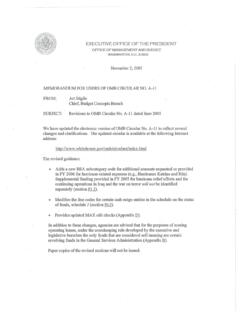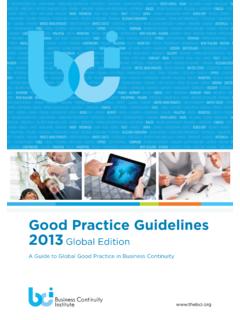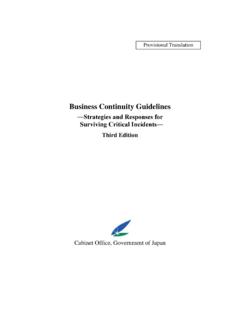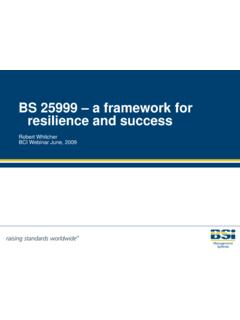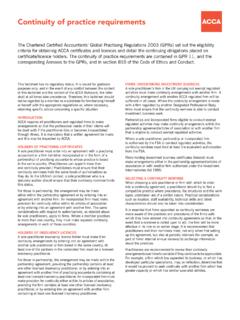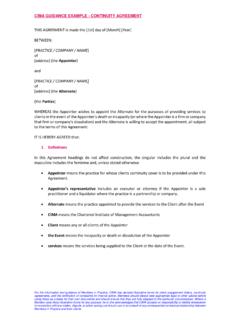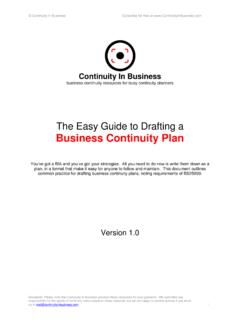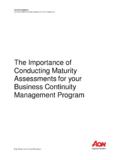Transcription of Federal Continuity Directive 1 (FCD 1) Federal Continuity ...
1 Federal Continuity Directive 1 (FCD 1) November 6, 2007 Federal Continuity Directive 1 (FCD 1) 6, 2007 Federal Continuity Directive 1 (FCD 1) Federal Executive Branch National Continuity Program and Requirements February 2008 FCD 1 iii TABLE OF CONTENTS 1. PURPOSE ..1 2. APPLICABILITY AND SCOPE ..1 3. SUPERSESSION ..1 4. 5. REFERENCES ..1 6. 7. 8. PROGRAM MANAGEMENT ..3 9. ELEMENTS OF A VIABLE Continuity CAPABILITY ..7 10. COORDINATION WITH STATE, LOCAL, TERRITORIAL, AND TRIBAL GOVERNMENTS, AND THE PRIVATE SECTOR ..11 11. Continuity PLAN OPERATIONAL PHASES AND 12. ROLES AND 13. POINT OF CONTACT ..21 14. DISTRIBUTION ..21 ANNEX A. PROGRAM PLANS AND PROCEDURES.
2 A-1 ANNEX B. RISK ANNEX C. BUDGETING AND ACQUISITION OF ANNEX D. ESSENTIAL D-1 ANNEX E. ORDERS OF SUCCESSION ..E-1 ANNEX F. DELEGATIONS OF AUTHORITY .. F-1 ANNEX G. Continuity G-1 ANNEX H. Continuity H-1 ANNEX I. VITAL RECORDS MANAGEMENT .. I-1 ANNEX J. HUMAN ANNEX K. TEST, TRAINING, AND EXERCISE (TT&E) PROGRAM .. K-1 ANNEX L. DEVOLUTION OF CONTROL AND DIRECTION ..L-1 ANNEX M. RECONSTITUTION OPERATIONS ..M-1 ANNEX N. Continuity PLAN OPERATIONAL PHASES AND N-1 ANNEX O. ACRONYMS .. O-1 ANNEX P. GLOSSARY .. P-1 ANNEX Q. AUTHORITIES AND REFERENCES .. Q-1 FCD 1 Federal Continuity Directive 1 (FCD 1) Number Date Office FCD 1 February 2008 FEMA National Continuity Programs TO: HEADS OF Federal DEPARTMENTS AND AGENCIES SUBJECT: Federal EXECUTIVE BRANCH NATIONAL Continuity PROGRAM 1.
3 PURPOSE: This Federal Continuity Directive (FCD) provides direction to the Federal executive branch for developing Continuity plans and programs. Continuity planning facilitates the performance of executive branch essential functions during all-hazards emergencies or other situations that may disrupt normal operations. The ultimate goal of Continuity in the executive branch is the continuation of National Essential Functions (NEFs). 2. APPLICABILITY AND SCOPE: The provisions of this FCD are applicable to the executive departments enumerated in 5 101, including the Department of Homeland Security, independent establishments as defined by 5 104(1), Government corporations as defined by 5 103(1), and the United States Postal Service. The departments, agencies, and independent organizations are hereinafter referred to as agencies.
4 The Continuity program elements outlined herein are for use at all levels of Federal executive branch organizations regardless of their location, and are also useful reference documents for non- Federal Government and private sector entities. 3. SUPERSESSION: The provisions of this FCD supersedes: a. Federal Preparedness Circular 60, Continuity of the Executive Branch of the Federal Government at the Headquarters Level During National Security Emergencies, and b. Federal Preparedness Circular 65, Federal Executive Branch Continuity of Operations, June 15, 2004. 4. AUTHORITIES: See Annex Q Authorities and References. 5. REFERENCES: See Annex Q Authorities and References. 6. POLICY: It is the policy of the United States to maintain a comprehensive and effective Continuity capability composed of Continuity of Operations (COOP) and Continuity of Government (COG) programs to ensure the preservation of our form of Government under the Constitution and the continuing performance of NEFs under all conditions (National Security Presidential Directive (NSPD)-51/Homeland Security Presidential Directive (HSPD)-20, National Continuity Policy).
5 Continuity requirements must be incorporated into 1 FCD 1 the daily operations of all agencies to ensure seamless and immediate continuation of Primary Mission Essential Function (PMEF) capabilities so that critical government functions and services remain available to the Nation s citizens. Continuity planning will occur simultaneously with the development and execution of Federal agency programs. This means that organizations must incorporate redundancy and resiliency as a means and an end. In support of this policy, the Federal executive branch has developed and implemented a Continuity program which is composed of efforts within individual agencies to ensure that their Mission Essential Functions (MEFs) continue to be performed during a wide range of emergencies, including localized acts of nature, accidents, and technological or attack-related emergencies.
6 These efforts include plans and procedures, under all readiness levels, that delineate essential functions, specify succession to office and emergency delegations of authority, provide for the safekeeping of vital records, identify a range of Continuity facilities and locations, provide for interoperable communications, provide for human capital planning, validate these capabilities through tests, training, and exercises (TT&E), specify a devolution of control and direction, and provide for reconstitution. All agencies, regardless of their size or location, shall have in place a viable Continuity capability to ensure continued performance of their agency s essential functions under all conditions. "COOP," or Continuity of Operations, is an effort within individual organizations ( , Federal executive branch departments and agencies) to ensure that MEFs and PMEFs continue to be performed during a wide range of emergencies, including localized acts of nature, accidents, and technological or attack-related emergencies.
7 "COG," or Continuity of Government, means a coordinated effort within each branch of Government ( , the Federal Government's executive branch) to ensure that NEFs continue to be performed during a catastrophic emergency. "ECG," or Enduring Constitutional Government, means a cooperative effort among the legislative, executive, and judicial branches of the Federal Government, coordinated by the President, as a matter of comity with respect to the legislative and judicial branches and with proper respect for the constitutional separation of powers among the branches, to preserve the constitutional framework under which the Nation is governed and the capability of all three branches of government to execute their constitutional responsibilities and provide for orderly succession, appropriate transition of leadership, interoperability, and support of NEFs during a catastrophic emergency.
8 7. BACKGROUND: Continuity planning is simply the good business practice of ensuring the execution of essential functions through all circumstances, and it is a fundamental responsibility of public and private entities responsible to their stakeholders. Today s asymmetric threat environment and the potential for no-notice emergencies, including localized acts of nature, accidents, technological emergencies, and military or terrorist attack-related incidents, have increased the need for robust Continuity capabilities and planning that enable agencies to continue their essential functions across a broad spectrum of emergencies. This, coupled with the potential for terrorist use of weapons of mass destruction (WMDs), has emphasized the importance of Continuity programs that ensure Continuity of essential government functions throughout the Federal executive branch.
9 Historically, the Federal Government has defined Continuity efforts using the terms COOP, COG, and ECG, as defined in Figure 1. Figure 1 2 FCD 1 The lessons we have learned from such catastrophic events as the attacks of September 11, 2001, and Hurricane Katrina in 2005 demonstrate the need to reemphasize Continuity as a good business practice to be incorporated into day-to-day planning, in order to reduce vulnerability, and ensure Continuity . On May 4, 2007, the President issued the National Continuity Policy ( Policy ) in NSPD-51/HSPD-20, which sets forth a new vision to ensure the Continuity of our Government. Pursuant to NSPD-51/HSPD-20, and in accordance with the National Continuity Policy Implementation Plan, the President directs the executive branch to reorient itself and to utilize an integrated, overlapping national Continuity concept to ensure the preservation of our Government and the continuing performance of essential functions.
10 Continuity responsibility and planning should not be a separate and compartmentalized function performed by independent cells of a few planners in each agency. It must be fully integrated into all aspects of an organization s daily operations, thus creating a culture of Continuity . 8. PROGRAM MANAGEMENT: An organization s resiliency is directly related to the effectiveness of its Continuity capability. An organization s Continuity capability its ability to perform its essential functions continuously rests upon key components and pillars, which are in turn built on the foundation of Continuity planning and program management. These pillars are Leadership, Staff, Communications, and Facilities. The Continuity program staff within an agency shall coordinate and oversee the development and implementation of Continuity plans and supporting procedures.
